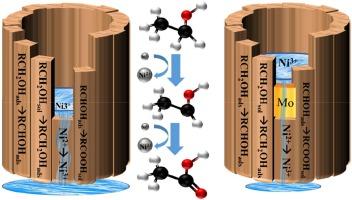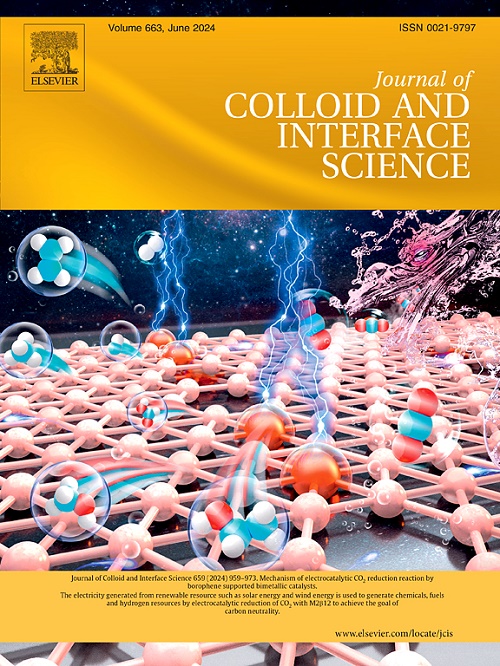Molybdenum-doping to enhance the deprotonation ability of nickel-based hydroxide electrocatalysts for ethanol oxidation
IF 9.4
1区 化学
Q1 CHEMISTRY, PHYSICAL
引用次数: 0
Abstract
With technological advancements, the practical application of ethanol oxidation reaction (EOR) is becoming increasingly promising, yet the need for higher ethanol concentrations highlights the growing importance of the deprotonation ability (Ni2+ to Ni3+) of the catalyst. The deprotonation ability is the key step for nickel-based catalysts in EOR, as it is essential for Ni2+ to continuously undergo deprotonation to transform into Ni3+ in order to maintain the continuous EOR. Herein, we developed Mo-doped Ni(OH)2 nanosheets by a hydrothermal method. The Mo-doped Ni(OH)2 nanosheets show excellent EOR performance due to the high valence doping of Mo, the onset potential of the oxidation peak (Ni2+ to Ni3+) appears at a position with a small overpotential,. The in-situ Raman spectroscopy technique further characterized the increase in NiOOH in the process of EOR. The Mo-doped Ni(OH)2 nanocomposite catalyst facilitates the oxidation of Ni2+ into Ni3+. Based on the above theoretical guidance, Mo-doped Fe/Ni(OH)2 nanosheets was designed and synthesized. The outstanding EOR performance of the Mo-Fe/Ni(OH)2-3 showed a potential of 1.352 V at 10 mA cm−2. The catalyst was used to design three-electrode reversible zinc-ethanol-air battery (T-RZEAB), which effectively overcomes the opposing kinetic and thermodynamic requirements for EOR and oxygen reduction reaction (ORR) catalysts in the oxygen electrode. The charging voltage of T-RZEAB with Mo-Fe/Ni(OH)2-3 is 240 mV lower than that of a traditional zinc-air battery at 25 mA cm−2.

掺钼增强镍基氢氧化物电催化剂在乙醇氧化过程中的去质子化能力。
随着技术的进步,乙醇氧化反应(EOR)的实际应用前景越来越广阔,但由于需要更高浓度的乙醇,催化剂的去质子化能力(Ni2+ 到 Ni3+)变得越来越重要。去质子化能力是镍基催化剂在 EOR 中的关键步骤,因为 Ni2+ 必须不断进行去质子化转化为 Ni3+,才能维持持续的 EOR。在此,我们采用水热法开发了掺杂 Mo 的 Ni(OH)2 纳米片。由于掺杂了高价态的 Mo,氧化峰(Ni2+ 到 Ni3+)的起始电位出现在过电位较小的位置,因此掺杂 Mo 的 Ni(OH)2 纳米片显示出优异的 EOR 性能。原位拉曼光谱技术进一步确定了 EOR 过程中 NiOOH 增加的特征。掺杂 Mo 的 Ni(OH)2 纳米复合催化剂促进了 Ni2+ 氧化成 Ni3+。根据上述理论指导,设计并合成了掺杂 Mo 的 Fe/Ni(OH)2 纳米片。Mo-Fe/Ni(OH)2-3 在 10 mA cm-2 时的电位为 1.352 V,具有出色的 EOR 性能。该催化剂被用于设计三电极可逆锌-乙醇-空气电池(T-RZEAB),有效地克服了氧电极对EOR和氧还原反应(ORR)催化剂的动力学和热力学要求相反的问题。在 25 mA cm-2 的条件下,使用 Mo-Fe/Ni(OH)2-3 的 T-RZEAB 的充电电压比传统锌-空气电池低 240 mV。
本文章由计算机程序翻译,如有差异,请以英文原文为准。
求助全文
约1分钟内获得全文
求助全文
来源期刊
CiteScore
16.10
自引率
7.10%
发文量
2568
审稿时长
2 months
期刊介绍:
The Journal of Colloid and Interface Science publishes original research findings on the fundamental principles of colloid and interface science, as well as innovative applications in various fields. The criteria for publication include impact, quality, novelty, and originality.
Emphasis:
The journal emphasizes fundamental scientific innovation within the following categories:
A.Colloidal Materials and Nanomaterials
B.Soft Colloidal and Self-Assembly Systems
C.Adsorption, Catalysis, and Electrochemistry
D.Interfacial Processes, Capillarity, and Wetting
E.Biomaterials and Nanomedicine
F.Energy Conversion and Storage, and Environmental Technologies

 求助内容:
求助内容: 应助结果提醒方式:
应助结果提醒方式:


